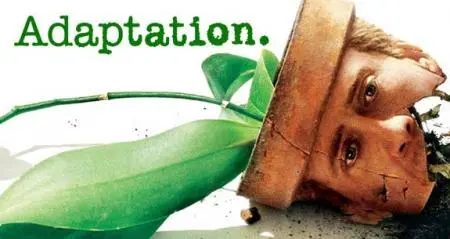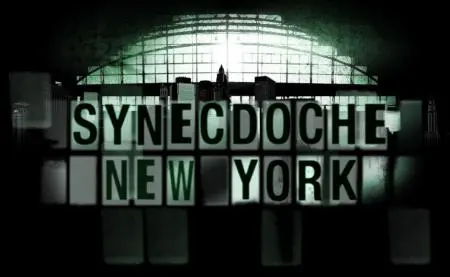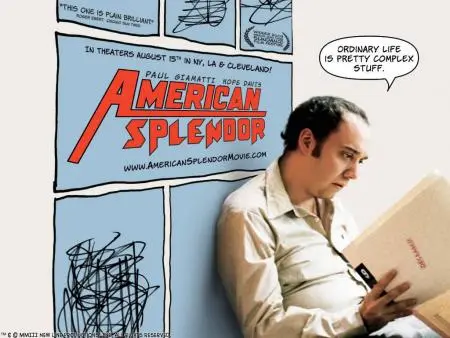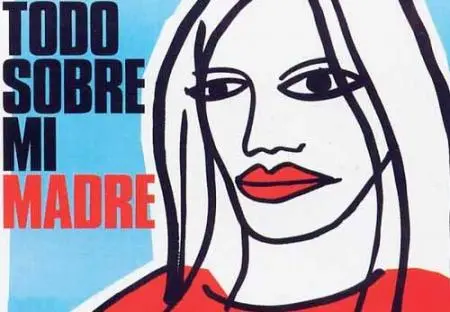Let’s just get one thing straight—I am not a film critic, but I enjoy the storytelling process so much that I like to watch movies that place the act of making fiction at the center of the story. In each of these movies, stories—some true and some fiction—are layered on top of each other in ways that highlight the process of making interesting stories (or of making stories interesting.) Each movie exploits the elements of fiction and of making truth into fiction in order to elevate what might be an ordinary story into an extraordinary movie-watching experience that causes any of us who create fiction to sit up and pay attention.
P.S. Spoiler Alert on all four movies. But I don't think knowing the end would at all ruin the watching experience, so I encourage you read on.
Adaptation
The word adaptation has several meanings—the first is a retelling of a story. We are all familiar with the idea of adapting a book to film. The word implies that not all things in the original version will appear in the adaptation. The word can also refer to the biological process of evolution in which a plant or animal changes in order to better survive in its current environment. The 2002 film Adaptation plays primarily with the first meaning of the word while also touching a bit on the second.
This movie was written by Charlie Kaufman after his attempt to adapt the 1998 nonfiction book The Orchid Thief, written by Susan Orlean, which she expanded from an article she wrote first for The New Yorker. Orlean’s book is about John Laroche, who was arrested in 1994 for poaching rare Ghost Orchids from a state preserve in Florida. To research the book, Orlean traveled to Florida and met Laroche and other poachers and discovered their deep passion for the rare flowers that drove them to steal.
When Kaufman decide to adapt the book to screen, he suffered from such severe writers’ block that he decided to fictionalize his attempt to write the screenplay instead of simply adapting the Orlean book into a literal interpretation of the real-life story. In Kaufman’s film version, a fictional Charlie Kaufman tries to write the screenplay, but is harassed by his twin Donald (not a real person), who moves into Charlie’s house and decides to become a screenwriter, too. Fictional Charlie can’t seem to find a strong storyline in the Orlean book and struggles with crafting a believable script, while Donald attends a screenwriting seminar and then writes a screenplay that Charlie thinks is too formulaic, but that sells for a lot of money.
Frustrated, Charlie travels to New York to get help from (the fictional) Orlean, but can’t face her. Donald travels with Charlie in order to help Charlie make sense of the script. He poses as Charlie to interview Orlean. He decides that Orlean’s version of the orchid thief story is too clean, and must therefore be fabricated. This prompts Donald and Charlie to follow Orlean to Florida where they discover Orlean is sleeping with (fictional) John Laroche and helping him cover up a scheme in which the rare orchids are actually being stolen for use in a new drug. Orlean catches Charlie spying on her and Laroche, so she forces him to drive to the swamps where the orchids are being poached in order to kill him. But the twins escape from her only to be shot at by Laroche. Laroche shoots Donald, so the twins attempt to escape in a park ranger’s truck only to crash. Donald dies in the crash, and Laroche closes in on Charlie only to be eaten by an alligator. Orlean is arrested, and Charlie returns home and finishes his script—this one based on the adventures he and his twin have just had. The movie ends with Charlie saying he wants Gerard Depardieu to play him in the film version.
The interesting part about this movie is that Charlie Kaufman (the real person) was unable to adapt the real book about real people into a viable, Hollywood-ready script, so he adapted his struggle to write the script into a story which itself became a fictionalization of both real stories full of fictional versions of real people doing things they never did (and presumably would never do) in real life. He goes so far as to create a twin to help him. The result is a movie that is perfect for Hollywood—full of murder, sex, and drugs—but nothing like the original book. In order to adapt the story to film, the story had to evolve to fit the entertainment environment. Kaufman, himself, had to evolve to be the kind of screenwriter that could write a Hollywood-worthy script, so he created a twin to bear that burden. Then he killed that twin off when he was no longer useful. The procession from writers’ block to an absurdly wrong retelling of Orlean’s original book is what makes this movie relevant to writers who struggle with plot lines that don’t fit the comfortable arcs that make up most fiction. Kaufman’s representation of that struggle could either be taken as encouragement to the blocked writer, or it might be read as a cautionary tale.
Synecdoche, New York
This is another movie by Charlie Kaufman, and true to form, it’s a total mind-bender. A synecdoche (pronounced si-neck-doh-key) means a word that refers to a whole thing by only mentioning part of the thing, or conversely, using the whole to refer to a part. The title is a play on the name of Schenectady (pronounced ske-neck-tah-dee), a small city in New York State where most of the story takes place.
The movie is about a sickly director named Caden Cotard . Upset that his wife Adele leaves him and takes their daughter, Olive, to Berlin to pursue her own artistic career, Cotard uses his winnings from a MacArthur grant to stage an artistic endeavor that pushes the boundaries of realism. To that end, he commissions the building of a life-sized replica of New York City in a warehouse in Schenectady. He hires an army of actors to populate the city and to live ordinary lives inside the fictionalized version of New York as a sort of play.
As time goes on, however, the lines between the fictional world of the actors acting out realistic versions of life and the real life of Cotard get hopelessly blurred. At one point, Cotard has an fling with Hazel, the box office manager, but ends up marrying Claire—one of the actresses hired to act in the play. His relationship with Claire is doomed to fail, and he attempts to carry on with the now married Hazel. Adele, in the meantime, has become a famous artist in Germany, and Cotard is worried that Adele’s friend Maria is negatively influencing their daughter. All these failures weigh so heavily on Cotard that he attempts to rectify some of them by employing actors to play the people in his life that have disappointed him. Eventually, there are actors playing the actors who were hired to act in the play which is a supposed representation of Cotard’s real life which is now, actually, completely enveloped by the process of directing this play. (Confused, yet?)
As Cotard gets sicker and sicker, he finally hires Sammy Baranthan, who has been stalking him, to play the role of Caden in the play within a play that is perpetually unfolding in the thriving fictional city inside the warehouse. Sammy, now as Caden, also has a relationship with Hazel. Caden then allows the actress who had been playing Adele’s housekeeper, Ellen, in the fictional world, to become the new director of the play, while Caden himself then plays Ellen, and spends the rest of his days in Adele’s (fictional) apartment as the world he created around him suffers some very real tragedies that ultimately leave only him and another actress who played the real Ellen’s mother. As he lays dying, he mentions that he has another idea for the play, at which point the actress who succeeded him as director gives him his final stage direction—die.
Once again, Kaufman plays with ideas of the artist losing himself in the creation of art. The creation is supposed to accurately imitate life but ends up spiraling out of control, carrying the artist into his own wormhole, and putting him at risk of total annihilation by his own creation. The idea of the city in the warehouse starts out simple enough, but when Cotard can’t draw the line between himself as director and the actors as actors hired to play real people, the layers of fiction start to suffocate him to the point that he can’t even continue to be himself. He then chooses to play a character that resides at the periphery of his real life family—the housekeeper of his wife’s apartment—in an attempt to escape the very real hell he has created in the warehouse. He’s doomed, of course, to be consumed entirely by his creation to the point that he must even be directed to die.
After watching this movie, you may want to smash all the mirrors in your house lest your reflection suddenly walk out and take over the role of playing you. It’s absurd to the extreme, but if you have ever tried to recreate reality either on the page or in a film, then you can relate to the desire to make it seem the most real without actually crossing the line that Cotard ends up crossing. As a writer, I appreciated the play on words in the title as well as the attempt by Kaufman to explain the mechanism between the creator and the created that seems to both define and destroy the other, which in a way, is what a synecdoche does.
American Splendor
The late Harvey Pekar was a curmudgeonly man who loved comics so much that he decided to write one—about himself. Unlike the heroes of the Marvel and DC comics, Pekar’s self-as-hero wore no cape and had no special powers or abilities. Rather Pekar wrote himself pretty much as he was—a self-loathing grump with health problems and a dead-end job. In 2003, directors Shari Springer Berman and Robert Pulcini brought Harvey Pekar’s life to the screen. The movie stars Paul Giamatti as Harvey Pekar and Hope Davis as Pekar’s wife, Joyce.
At first look, it seems like a relatively straightforward biopic of a man who made fiction of himself in a series of comics about his job, his struggle with cancer, his relationship with Joyce (a comic book store owner who was a fan of his), and even his experience as a writer of comics that become quite popular. This fictionalization of a man who fictionalizes his life is enough to make the movie interesting. However, the directors don’t leave it at that. The movie also includes the real life Harvey and Joyce who are shown watching the creation of the fictionalized world in the movie. They weigh in on how the actors portray them and comment on what it feels like to watch a movie being made about their lives.
When you watch this movie, you don’t just learn about the real-life man and his life-made-art comic series, you also witness how the actors studied the real Harvey and Joyce and attempt to portray them faithfully on screen. While Giamatti’s version of Pekar proves what an incredible actor he is, it also highlights the fact that it is still only a representation of the real person, just as the comics are a representation. The effect is an extra emphasis on what the real Pekar is actually like, and despite all the talent around him, it’s the real Harvey who steals the show from all the fictionalized versions that were created to make him interesting.
All About My Mother (Todo Sobre Mi Madre)
This movie adapts its title from a 1950’s flick called All About Eve which is, itself, an adaptation of a short story by Mary Orr called “The Wisdom of Eve” that first appeared in the May 1946 issue of Cosmopolitan, and was based on a real story that Orr heard about a real actress. The story goes like this: an aging Broadway star hires her biggest fan and most ardent admirer, Eve, as an assistant. At first Eve seems innocent and eager to please her idol, but instead, she is quietly insinuating herself into the star’s life and personal affairs. Before long, young Eve is a star in her own right, and is soon pushing her former mentor out of the spotlight. At the end, Eve is targeted by a new, younger actress, who sets her sights on Eve’s success, thus completing the circle of deceit, fame, and disgrace.
In Director Pedro Almodóvar’s movie All About my Mother, a young man, Esteban, and his mother, Manuela, who works in the organ donation program at the local hospital, attend a play in which the aging actress Huma Rojo stars. Esteban is a big fan of Huma, and after the show he runs after her car to get an autograph. He is hit by another car and killed. Esteban’s heart is donated to another patient.
Esteban wished to be a writer, and wrote a story about his mother. In it, he expressed his wish to also meet his father. This prompts Manuela to travel to Barcelona to find Lola, the transvestite (whose real name is Esteban) that fathered her son. As Manuela had never told Lola about Esteban in the first place, both his life and his death would be news to Lola.
Along the way, she becomes involved with Rosa, a nun who is pregnant with none other than the philandering Lola’s child. She takes Rosa in and cares for her. Then after going to see a showing of a play starring Huma Rojo, Manuela meets the star and starts working as her assistant. Just like the original Eve, Manuela manages to get completely involved in Huma’s life, even filling in for Nina, Huma’s co-star and heroin-addicted lover, during one of Nina’s benders. The role that Manuela plays for Nina is a role she had played before when she was younger and acted alongside Lola/Esteban. After Rosa dies in child birth, Manuela adopts Rosa’s baby, also named Esteban. She hands her job as assistant to Huma off to her friend Agrado, who is also a transvestite and a former prostitute, and she then returns to Madrid to raise Baby Esteban.
Pedro Almodóvar dedicates the movie "To all actresses who have played actresses. To all women who act. To men who act and become women. To all the people who want to be mothers. To my mother." The movie is all about the layering of selves, of playing roles, of acting out the same stories over and over again. In this movie, the role of Eve is first played by the innocent Esteban and then by Manuela, as she enters into the life that Esteban was just beginning in order to reconcile her present life as mourning mother with her past life as an actress and lover to Lola/Esteban. Manuela, however, is not like the typical Eve character, in that her involvement with Huma is not intended as a ploy for stardom. On the contrary, Manuela seems to be propelled by unknown forces into the role of Eve in order to set her life right by confronting her past, dealing with her grief, and finally moving on to a new role as surrogate mother to Rosa’s baby.
All the characters, it seems, play the roles of other people. Manuela, who at first seems to be just a hardworking single mother with a desk job was actually an actress before her son was born. Rosa is a nun, but she is pregnant by a transvestite. Both Lola and Agrado were born men but now live as women. Huma is a professional actress. Even the teenage Esteban lives on in a way as the beating heart of another person. No character lives just one life in one body as one story, and each character has a fictionalized self that is more real than the factual self (if such a thing exists.) The point is that creation of self is yet another process in which fiction and reality play off each other to a point of absurdity.
Why Watch?
I originally intended this article to be about clever word usages in movies, like that of Synecdoche, New York, but it has ended up being about why artists create and what happens when the act of creation is taken too literally by creators themselves. These four films highlight the difficulty of trying to fictionalize reality in order to make meaning where none appears to exist. Each includes characters who are not satisfied with their existence, so they try to make sense of it by turning themselves into stories because, like the real (and fictional) Charlie Kaufman of Adaptation, they have this notion that a story must make sense. I think that desire to make sense drives us writers and artists to create, even if in the act of doing so we destroy something about ourselves. As writers, we need to have these conversations with ourselves from time to time to both remember why we set ourselves on this sometimes painful path and to warn ourselves off getting too involved with our own art lest we need someone else to tell us when to finally stop.

About the author
Taylor Houston is a genuine Word Nerd living in Portland, OR where she works as a technical writer for an engineering firm and volunteers on the planning committee for Wordstock, a local organization dedicated to writing education.
She holds a degree in Creative Writing and Spanish from Hamilton College in Clinton, NY. In the English graduate program at Penn State, she taught college composition courses and hosted a poetry club for a group of high school writers.
While living in Seattle, Taylor started and taught a free writing class called Writer’s Cramp (see the website). She has also taught middle school Language Arts & Spanish, tutored college students, and mentored at several Seattle writing establishments such as Richard Hugo House. She’s presented on panels at Associated Writing Programs Conference and the Pennsylvania College English Conference and led writing groups in New York, Pennsylvania, and Colorado for writers of all ages & abilities. She loves to read, write, teach & debate the Oxford Comma with anyone who will stand still long enough.











